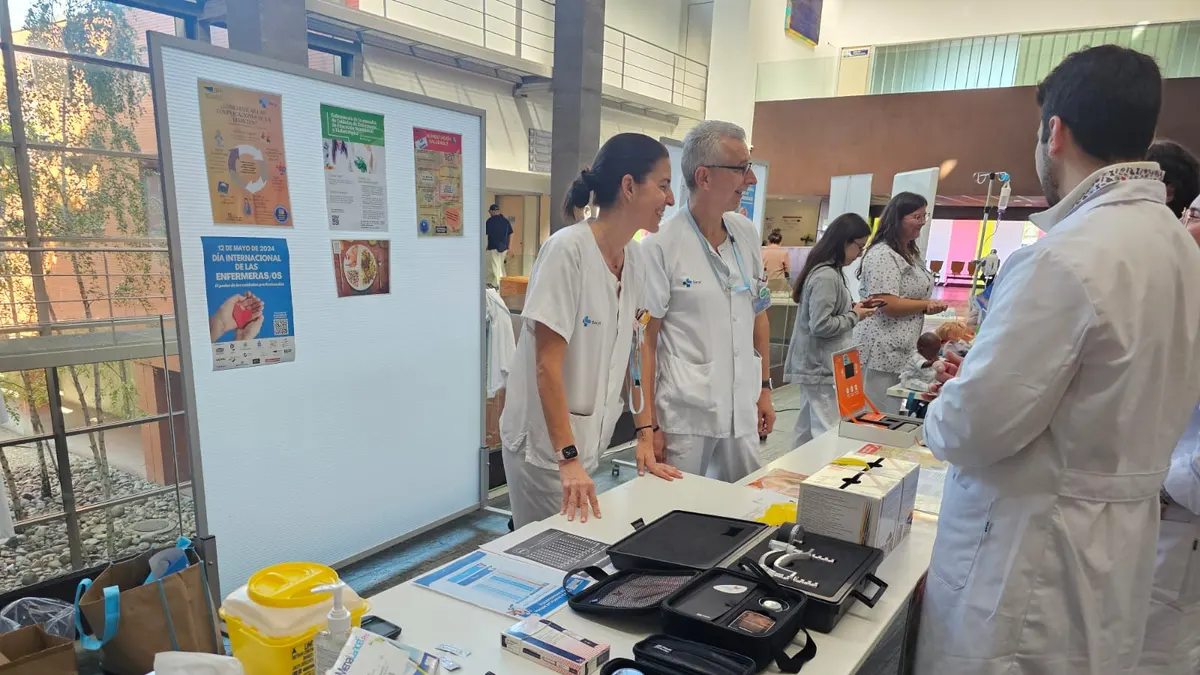Barrington School District 220 held a series of sessions – officially called community engagement meetings – seeking to provide information and field stakeholders’ questions as the district looks to have a multi-million dollar referendum on the November ballot.
If successful this year, this latest turn to taxpayers would come four years after a $147 million bond referendum was approved, money the district used to make upgrades, additions and renovations at several of its 12 schools — including Barrington High School.
“We understand we can’t keep coming back to the community. That’s why we’re trying to get feedback on a range of options so that we don’t keep coming back with more and more referendums to keep raising those dollars,” Superintendent Craig Winkelman told attendees of the March 11 session.
Alexa Albrecht, who has two children enrolled in Barrington School District 220 in Barrington, asks a question during the March 9, 2024 community engagement meeting held at Barrington High School to discuss a possible ballot referendum. (Michael Schmidt/Pioneer Press)
Barrington School District 220 officials made a presentation to district stakeholder during a March 9, 2024 community engagement meeting held at Barrington High School in Barrington to discuss a possible ballot referendum in November. (Michael Schmidt/Pioneer Press)
He explained that the successful March 2020 referendum provided the district with only a quarter of the total $600 million leaders estimate the district needs to make capital improvements.
“We know we only did 25%,” the superintendent said, referring to the last ballot measure.
More than two dozen parents and community members gathered at Arnett C. Lines Elementary School for the March 11 session held there. It was the third of four the district held – including one held virtually – and Winkelman and Assistant Superintendent of Schools Josh Carpenter explained the district’s 10 renovation and space needs.
School district leaders presented three proposals to fund upgrade projects, which range in estimated cost from $45 million to $76 million. In addition to the in-person sessions, the district also reached out through phone and digital surveys.
District leaders are asking the community to rank 10 projects the district has identified and offer feedback on three funding plans.
The projects include: A new, larger and accessible auditorium at Barrington High School for $35 million. New music rooms for band, orchestra and chorus for $10 million. New science, technology, engineering, art and math (STEAM) labs at $1 million. Renovation and enhancements of fine arts classrooms, carrying an estimated $5.9 million price tag. Several infrastructure improvements, including plumbing and security upgrades for about $9 million, and the creation of makerspaces and other creative enhancements, as well as upgraded science labs – all for about $16 million.
“We’re collecting information on what you value,” Winkelman told the audience March 11.
The highest funding level that covers paying for all of the projects the district identified is projected at $75.5 million, Winkelman said. The superintendent said the owner of a $500,000 home in Barrington would pay an additional $289 in SD220-assessed property taxes for 20 years.
“I’m all in,” said Lucinda McDonald, a parent of two sons at Barrington High School who are in band, orchestra and robotics. “I say spend the money. We should have spent the money the first time around. When you think about the wealth in our community, it’s really not that much. If you went to Starbucks every day, $300 bucks over a whole year, it’s not really that much.”
She and other community members in attendance pointed to what they consider disrepair, aging infrastructure and space limitations at school buildings throughout the district that need to be addressed.
Two other funding amounts are being presented as options. A “medium” funding level that funds many improvements – which were not specifically identified at this point – would provide an estimated $59 million. That would be an increase of $227 in property taxes on a home valued at $500,000. Then a “low” funding level option would bring the district $45 million and increase taxes on a $500,000 home by $172 each year for 20 years, according to date district officials provided.
Winkelman told of the local and national accolades the district – which enrolls over 8,100 students – has garnered. He said SD220 spends less than the state average on operations, which allows the district to have the second lowest tax rate of $4,659 compared to area peer school districts.
However, capital needs are necessary, he said. A top priority for the community continues to be a new fine arts center at the high school, as identified by 4,000 people who participated in the district’s strategic planning process. The current auditorium was built in 1960 and is not accessible or Americans with Disabilities Act compliant, but is used by the district or community 323 days out of the year – including 42 community rentals for programming and dance ensembles, he said.
Not only would a building addition be more spacious and state-of-the-art, it would increase seating by 65 to a total of 769 seats, Winkelman said.
“We have a history that we don’t collect more than we need and bank it,” Winkelman said of the district’s budget policy. “We have been operating with the funds [taxpayers] have provided, but we don’t have enough to do it. We come to you when we need the money because our annual budget cannot keep up. We don’t have enough money coming in to do the same things you see in other districts.”
Winkelman explained that if the November referendum is rejected, it will be up to the administration and the school board to determine if class sizes would need to be adjusted, or if course offerings, programs, staff or other budget line items need to be cut to accommodate some of these needs.
District officials were set to provide at the April 2 school board meeting feedback on the community information collected.
Elizabeth Owens-Schiele is a freelancer.




